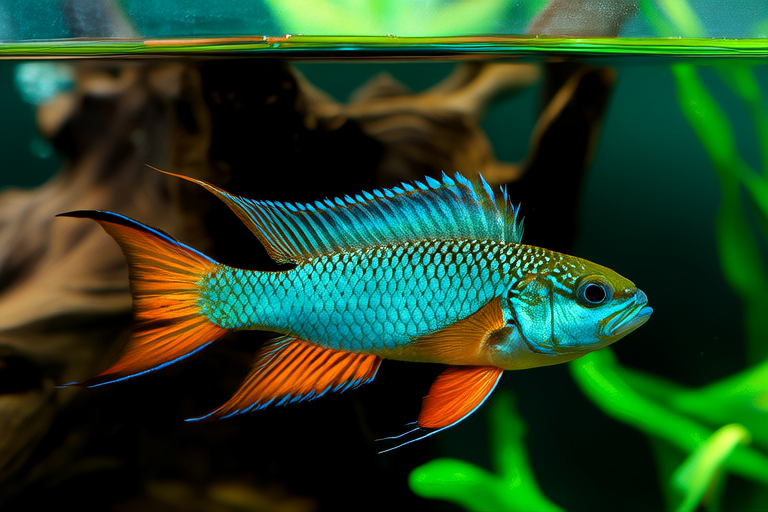The Ultimate Guide to Keeping Your Rajah Cichlid Happy and Healthy
The Rajah Cichlid, also known as the Rajah Loach or Rajah Dwarf Cichlid, is a fascinating fish species native to South America. This guide aims to provide you with all the necessary information to ensure your Rajah Cichlid thrives in its aquarium environment. From tank setup to diet and breeding, this comprehensive guide will cover everything you need to know.
Optimal Tank Setup
Creating an ideal habitat for your Rajah Cichlid involves several key elements. First, the tank size should be no less than 30 gallons (114 liters) for a single fish, but larger tanks are recommended for better swimming space and stress reduction. A well-planted tank with plenty of hiding spots can help mimic their natural habitat and reduce stress.
Substrate choice is crucial; opt for fine sand or smooth gravel to prevent injuries from sharp edges. Decorations such as driftwood, rocks, and caves can offer hiding places and territorial boundaries. Adequate filtration is essential, as Rajah Cichlids produce waste quickly. Consider a high-quality filter that provides mechanical, chemical, and biological filtration.
Proper lighting is important for both plant growth and the fish’s overall well-being. Use a full-spectrum LED light that simulates natural daylight, and provide at least 8-12 hours of light per day.
Water Parameters
Maintaining stable water conditions is vital for the health of your Rajah Cichlid. The pH level should ideally be between 6.5 and 7.5, reflecting the slightly acidic to neutral range found in their natural habitats. Temperature should be kept between 75-82°F (24-28°C). Regular testing of these parameters using reliable test kits is recommended.
Adequate aeration and circulation are necessary to maintain oxygen levels and prevent stagnation. A gentle flow can also help keep the substrate clean. Weekly partial water changes of about 25% are advised to remove accumulated toxins and maintain water quality.
Diet Requirements
Rajah Cichlids are omnivorous, meaning they eat both plant matter and small animals. Their diet should include a variety of foods to ensure balanced nutrition. High-quality flake food, pellets, and freeze-dried or frozen bloodworms, brine shrimp, and daphnia are excellent choices. Vegetables like zucchini, spinach, and peas can be offered as occasional treats.
Feed your Rajah Cichlid two to three times daily, offering only what they can consume within a few minutes to avoid overfeeding and water pollution. Overfeeding can lead to digestive issues and poor water quality.
Compatible Tank Mates
Selecting appropriate tank mates for your Rajah Cichlid is critical to maintaining harmony within the aquarium. Compatible species should have similar water parameter needs and temperament. Peaceful community fish like neon tetras, cardinal tetras, and harlequin rasboras can coexist with Rajah Cichlids.
It’s important to note that while Rajah Cichlids are generally peaceful, they may become aggressive during spawning or when defending territory. Therefore, it’s best to introduce them to the tank last and ensure there are enough hiding spots and territories for each fish.
Common Health Issues
Like any other fish, Rajah Cichlids are susceptible to various health problems. Common ailments include fin rot, ich, and bacterial infections. Fin rot typically presents as frayed or discolored fins and can be treated with medications specifically designed for this condition.
Ich, characterized by white spots on the fish’s body, requires treatment with ich-specific remedies. Bacterial infections may cause lethargy, loss of appetite, and reddened areas on the body. Quarantine new additions to the tank to prevent introducing diseases. Regular observation and prompt action can help address health issues before they escalate.
Breeding Tips
Breeding Rajah Cichlids can be a rewarding experience. To encourage breeding, start by creating a breeding pair. Provide a spacious, well-planted tank with ample hiding spots and caves. Raise the water temperature slightly, around 82-84°F (28-29°C), and increase the frequency of feedings to promote spawning readiness.
Once the pair is ready, they will typically choose a suitable spot, such as a cave or flat surface, to lay their eggs. The female will lay hundreds of adhesive eggs, which the male then fertilizes. Both parents take turns guarding the eggs until they hatch, usually after about 48-72 hours. After hatching, the fry will remain attached to the substrate for a few days before becoming free-swimming.
Feed the fry with infusoria, newly hatched brine shrimp, or specialized fry food. Continue feeding them small, nutritious meals multiple times a day to support their rapid growth.
Conclusion
By following the guidelines outlined in this ultimate guide, you can ensure your Rajah Cichlid lives a long, healthy, and happy life. Remember that regular maintenance, proper nutrition, and attention to water quality are key factors in keeping your fish thriving. With the right care and environment, your Rajah Cichlid will bring joy and beauty to your aquarium for years to come.
